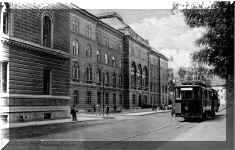|
Sarajevo


 |
|
History
The city of Sarajevo has been the site of three
seemingly unrelated major events: World War I began there; the city was
the host of the XXIII Winter Olympic Games; and today, it is a shattered
center of ethnic conflict as Yugoslavia divides into separate states.
Why have these events taken place in Sarajevo?
Located at a cultural crossroads between West and East, Sarajevo’s
history has been determined by its ethnic geography,
by the presence of its three major ethnic groups and the relationships
among them
The area of present day Sarajevo has a long and rich
history dating back to the Stone age, when the Butmir Culture flourished
in the area. However, little material evidence of this is available,
mostly due to later construction. Several Illyrian settlements existed
in the area before it was conquered by Rome in 9 CE. During Roman times,
a town named Aquae Sulphurae existed on the location of present day
Ilidža, a Sarajevo suburb to the southwest of the city.
The year usually mentioned as the city's founding is
1461, when the first Ottoman governor of Bosnia, Isa-beg Ishaković,
transformed this village cluster into a city and a state capital by
building a number of key objects, including a mosque, a closed
marketplace, a public bath, a hostel and the Governor's castle (Saray)
which gave the city its present name (see also: Etymology of the Name of
Sarajevo). Sarajevo flourished in the 16th century when its greatest
donor and builder Gazi Husrev-beg built most of what is now the old
city. By the late 17th century, Sarajevo was the most important city in
the Balkans after Istanbul.
In a raid led by Prince Eugene of Savoy in 1697
against the Ottoman Empire, Sarajevo was burned down and leveled. The
city was later rebuilt, but never fully recovered from the destruction.
The capital of Bosnia was transferred to Travnik. In 1878, Bosnia was
occupied by Austria-Hungary, and Sarajevo was quickly brought up to the
standards of the industrial age.
In the event that triggered World War I, Franz
Ferdinand, Archduke of Austria and his wife were assassinated in
Sarajevo on 28 June 1914. Following the war, in the kingdom of
Yugoslavia, Sarajevo was the capital of the Drinska banovina, one of the
country's chief provinces. After World War II, Sarajevo grew rapidly as
it became an important regional industrial center in Yugoslavia. Modern
city blocks were built west of the old city, adding to Sarajevo's
architectural uniqueness. The peak of city growth occurred in the early
1980s, when Sarajevo hosted the 1984 Winter Olympics.
On April 6, 1992, Sarajevo was surrounded by forces
of Bosnian Serbs. The warfare that lasted until October 1995 resulted in
large scale destruction and dramatic population shifts (see Siege of
Sarajevo for details). Reconstruction of Sarajevo started as soon as the
war ended, in 1995. By 2003, most of the city had been rebuilt, with
only a few remaining visible ruins in the city center. Modern business
buildings and skyscrapers have since been constructed throughout the
city.
|
 %20of%20img03b.jpg) |